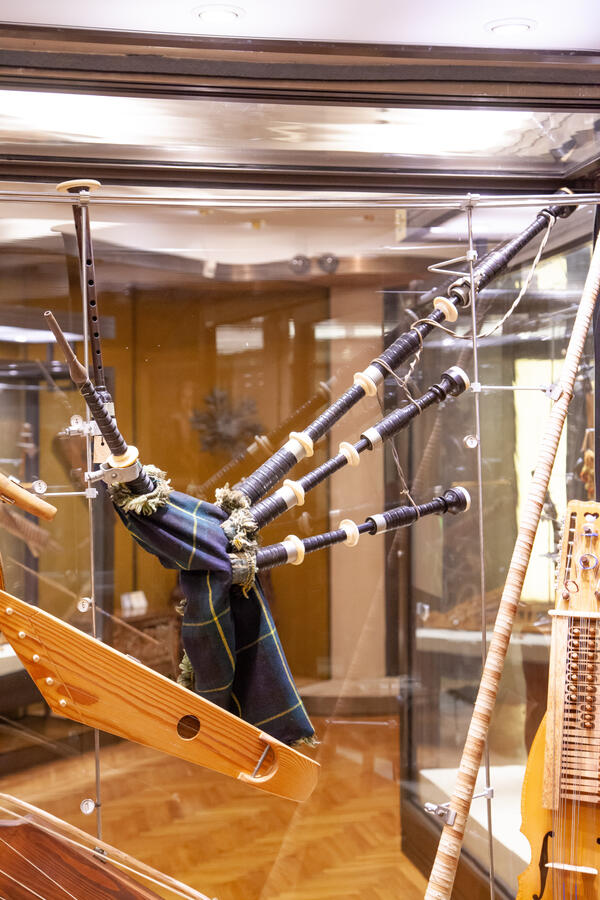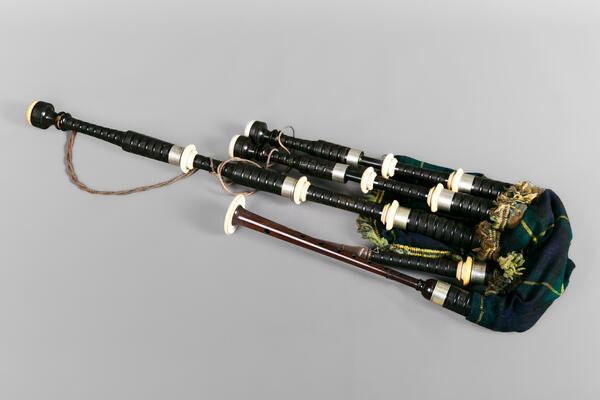Various types of bagpipes exist in countries all over the world, but the best-known example is a Scottish instrument known as the Great Highland bagpipe. The collection of the Russian National Museum of Music includes a bagpipe made in the 1860s. It was manufactured by the company of John and Robert Glen in Edinburgh.
The instrument consists of an air bag made of sheepskin. It is equipped with a small blowpipe for air supply, a chanter with nine holes for playing the melody, and three drones. The drones produce a constant harmonizing note throughout playing.
The instrument may be held in front of the body or under the arm. A musician supplies air into the bag through a blowpipe and, pressing the air bag with the left elbow, starts playing the chanter with the right hand.
The first mentions of bagpipes date back to ancient Greek sources of the 4th century BC. Between the 1st and 3rd centuries AD, the bagpipe was popular in Rome, but it was considered an instrument of the lower classes due to its allegedly vulgar sound.
There is a legend of how bagpipes came to the British Isles. According to this story, when Julius Caesar invaded Britain, he brought one hundred bagpipes as a secret weapon. At the crucial point during a battle, the Romans started playing their bagpipes simultaneously. The sound scared away the enemy’s horses, and the British were defeated.
The main repertoire of Scottish bagpipe music was formed after the 16th century. It included marches and battle tunes played to support the morale of the fighters. In the mid-18th century, the Scottish army was defeated by the British in the Battle of Culloden. The British government banned the traditional highland dress and bagpipes. However, the instrument was so popular that the custom was not abandoned.
In 1783, the Highland Society organized a bagpipe contest. Many participants represented the famous dynasties of bagpipers — the MacCrimmons and MacArthurs.
The standard orchestra consisting of bagpipes and drums was established around 1881 when the British government decided to reorganize its military regiments. Such orchestras played into battle during World War I. Nowadays, the Great Highland bagpipe experiences a new surge of popularity.
The instrument consists of an air bag made of sheepskin. It is equipped with a small blowpipe for air supply, a chanter with nine holes for playing the melody, and three drones. The drones produce a constant harmonizing note throughout playing.
The instrument may be held in front of the body or under the arm. A musician supplies air into the bag through a blowpipe and, pressing the air bag with the left elbow, starts playing the chanter with the right hand.
The first mentions of bagpipes date back to ancient Greek sources of the 4th century BC. Between the 1st and 3rd centuries AD, the bagpipe was popular in Rome, but it was considered an instrument of the lower classes due to its allegedly vulgar sound.
There is a legend of how bagpipes came to the British Isles. According to this story, when Julius Caesar invaded Britain, he brought one hundred bagpipes as a secret weapon. At the crucial point during a battle, the Romans started playing their bagpipes simultaneously. The sound scared away the enemy’s horses, and the British were defeated.
The main repertoire of Scottish bagpipe music was formed after the 16th century. It included marches and battle tunes played to support the morale of the fighters. In the mid-18th century, the Scottish army was defeated by the British in the Battle of Culloden. The British government banned the traditional highland dress and bagpipes. However, the instrument was so popular that the custom was not abandoned.
In 1783, the Highland Society organized a bagpipe contest. Many participants represented the famous dynasties of bagpipers — the MacCrimmons and MacArthurs.
The standard orchestra consisting of bagpipes and drums was established around 1881 when the British government decided to reorganize its military regiments. Such orchestras played into battle during World War I. Nowadays, the Great Highland bagpipe experiences a new surge of popularity.






